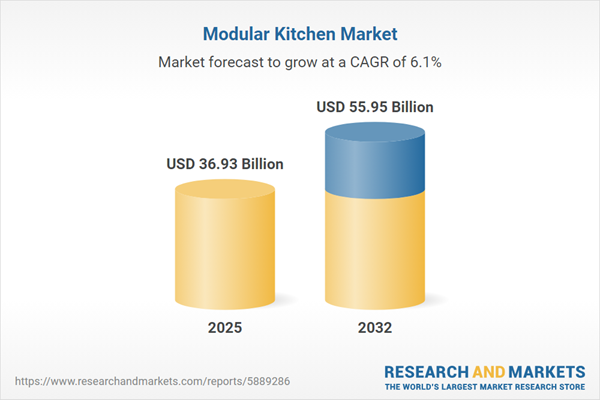Speak directly to the analyst to clarify any post sales queries you may have.
The modular kitchen market is undergoing swift transformation as tailored solutions, advanced technologies, and flexible configurations become essential across both residential and commercial segments. Demand for adaptability, cohesion, and operational efficiency is fostering accelerated innovation and new growth avenues.
Market Snapshot: Modular Kitchen Market Growth
The Modular Kitchen Market grew from USD 34.95 billion in 2024 to USD 36.93 billion in 2025 and is projected to reach USD 55.95 billion by 2032, maintaining a steady CAGR of 6.05%. This robust market expansion reflects sustained interest from both residential and commercial buyers, along with increased investments from manufacturers in technology and design advancements. The sector is highly influenced by evolving consumer expectations for personalized solutions and enhanced kitchen functionality.
Scope & Segmentation of the Modular Kitchen Sector
This report provides comprehensive coverage of the modular kitchen industry's multi-faceted landscape, assessing major growth drivers and detailed segmentation insights across the following:
- Product Types: Base cabinets, floor cabinets, tall cabinets, wall cabinets, kitchen islands, kitchen accessories, modular kitchen appliances
- Styles: Modern & contemporary, rustic, Scandinavian, traditional, transitional
- Materials: Glass & acrylic, laminates & veneers, metals (aluminum, stainless steel), stone & quartz, wood-based (high-density fiberboard, medium-density fiberboard, plywood, solid wood)
- Layout Designs: L-shaped, parallel, peninsula, straight-line, U-shaped kitchens
- Distribution Channels: Offline showrooms, online platforms (brand websites, eCommerce platforms)
- End Users: Commercial (corporate offices, hotels & resorts, restaurants & cafes), residential buyers
- Regions Covered: Americas (North America, Latin America, including the United States, Canada, Mexico, Brazil, Argentina, Chile, Colombia, Peru), Europe, Middle East & Africa (featuring key markets like the UK, Germany, France, UAE, Saudi Arabia, South Africa, Kenya), and Asia-Pacific (major economies such as China, India, Japan, Australia, South Korea, Indonesia, Thailand, Malaysia, Singapore, Taiwan)
- Leading Companies: Alea Modular Kitchen, Boston Cabinets Inc., Bulthaup GmbH & Co KG, Easylife Kitchens, Godrej & Boyce, Häcker Küchen, Hettich Holding, IKEA, Julius Blum, Kohler, Kutchina, L'Atelier Paris Haute Design, LINEADECOR, Nexus Interio, Nobia AB, Poggenpohl, SieMatic, Snaidero Rino, Wudley Modulars, and others
Key Takeaways for Senior Decision-Makers
- Personalization and configurational flexibility are now core market drivers, supporting both expansive layouts and compact, high-efficiency kitchen solutions.
- Integration of smart appliances and advanced storage solutions is raising operational standards, especially for tech-conscious residential and commercial clients.
- Sustainable materials and eco-friendly finishes are gaining wider adoption, enhancing the sector's environmental credentials and appeal among conscious buyers.
- Digitalization across supply chains, including real-time inventory systems and online design tools, is enabling faster response to shifting demand and improving client engagement.
- Regional diversity shapes market opportunities—from premium, artisanal trends in Europe to rapid urban, cost-sensitive growth in Asia-Pacific and sustainable innovation in the Americas.
- Partnerships and supply chain diversification support business resilience, particularly in navigating regulatory or trade challenges.
Tariff Impact: Strategic Adaptation in 2025
Recent United States tariff measures on key inputs such as steel and specialized fittings have prompted modular kitchen manufacturers to reevaluate sourcing and pricing strategies. Many firms are prioritizing nearshoring and local supplier relationships, seeking to manage rising component costs and tighten supply chain agility. These shifts are expected to reinforce operational continuity and maintain competitive positioning despite increased regulatory complexity in global trade.
Methodology & Data Sources
This report combines primary research—direct interviews with industry executives, designers, and supply chain specialists—with rigorous secondary validation. Sources include industry publications, regulatory filings, and material certifications, strengthened by peer review and stakeholder feedback to ensure robust, unbiased insights.
Why This Modular Kitchen Market Report Matters
- Enables strategic planning by highlighting the most relevant market opportunities and risk mitigation approaches for manufacturers and suppliers.
- Supports informed investment and product decisions by providing granular analysis of regional trends, consumer behaviors, and technology advances.
- Equips leaders with actionable recommendations to optimize supply chains, drive sustainability, and harness digital innovation for sustained growth.
Conclusion
The modular kitchen market continues to evolve through dynamic consumer demands, technological progress, and global supply chain shifts. Senior decision-makers equipped with granular, segment-focused intelligence will be best positioned to maximize growth and operational efficiency in this fast-changing landscape.
Additional Product Information:
- Purchase of this report includes 1 year online access with quarterly updates.
- This report can be updated on request. Please contact our Customer Experience team using the Ask a Question widget on our website.
Table of Contents
3. Executive Summary
4. Market Overview
7. Cumulative Impact of Artificial Intelligence 2025
Companies Mentioned
The companies profiled in this Modular Kitchen market report include:- Alea Modular Kitchen
- Boston Cabinets, Inc.
- Bulthaup GmbH & Co KG
- Easylife Kitchens
- Ernestomeda
- Godrej & Boyce Manufacturing Company Limited
- Häcker Küchen GmbH & Co. KG
- Hettich Holding GmbH & Co. oHG
- Inter IKEA Systems B.V.
- Julius Blum GmbH
- Kohler Co.
- Kutchina
- L’Atelier Paris Haute Design, LLC
- LINEADECOR
- Meubles Demeyere
- Nexus Interio Private Limited
- Nobia AB
- nobilia-Werke J. Stickling GmbH & Co. KG
- NOBLESSA S.A.S
- Pedini SpA
- Poggenpohl
- SieMatic Möbelwerke GmbH & Co. KG
- Sleek International Pvt Ltd. by Asian Paints Ltd.
- Snaidero Rino Spa
- Wudley Modulars
Table Information
| Report Attribute | Details |
|---|---|
| No. of Pages | 180 |
| Published | November 2025 |
| Forecast Period | 2025 - 2032 |
| Estimated Market Value ( USD | $ 36.93 Billion |
| Forecasted Market Value ( USD | $ 55.95 Billion |
| Compound Annual Growth Rate | 6.0% |
| Regions Covered | Global |
| No. of Companies Mentioned | 26 |









